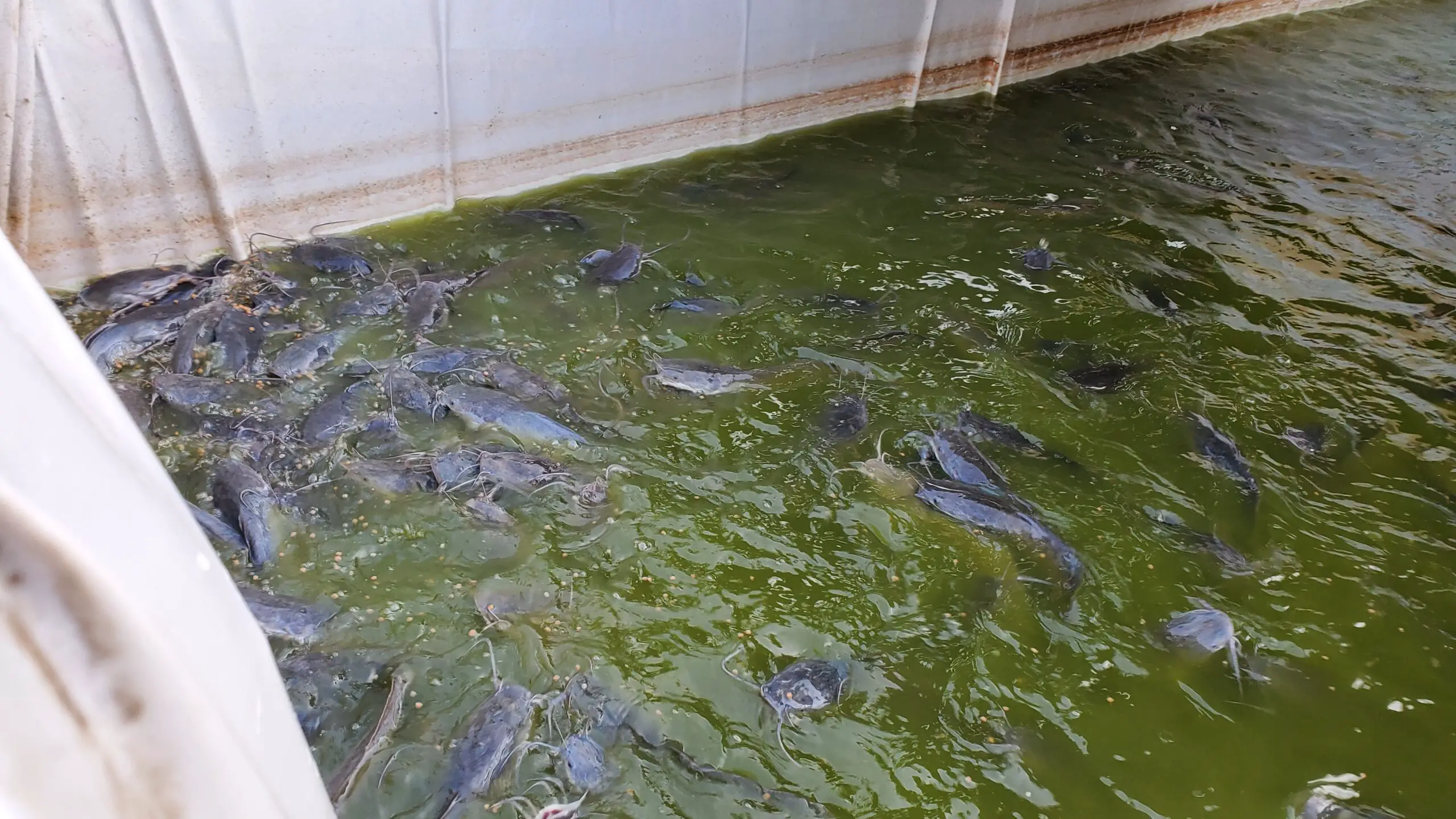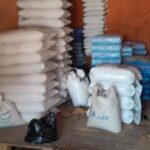Some links on this page may contain affiliate links which means that, if you choose to make a purchase using the link, Agricfy.com may earn a small commission at no extra cost to you. For more information, go to our Affiliate Disclosure Page!
Introduction
An aspect of fish farming that has drawn a lot of questioning is how to calculate stocking density and the quantity and size of fish to be kept in cages or ponds. Although this is a very good question, many farmers still have no idea of the correct answer.
- Introduction
- What is a Pond?
- Overstocking And Its Effect on Your Fish
- Stocking Density
- Pond Carriage Capacity
- Calculating
- Importance of Calculating Stocking Density
Pictures of chickens confined in tiny cages influence many people’s perceptions of animal welfare. Some people extended their thoughts about environments in land-based farming systems to fish farming. However, any assumption about fish farms from land-based farming systems must be done with great care.
The most effective way to add fish to your fish tank or water garden is through a systematic process, despite the temptation to add lots of fish at once. The pond ecosystem maintains balance when the appropriate numbers of fish are present at any given time. The right amount of water and enough space are essential for the health and vitality of fish.
We’ll go over how to calculate stocking density correctly, why it’s important, and what problems can arise if you don’t. However, before proceeding, let us define what a pond is.
What is a Pond?

A pond is any equipment used in raising your aqua animal either catfish, crab, tilapia, and so on.
There are different types of ponds that are available for you to use in raising your animal. If you don’t know the type of ponds for fish farming, then read the article I have on it.
Overstocking And Its Effect on Your Fish
Overstocking is the process of putting more fish in a pond than the required quantity.
Let me use this example, imagine putting 10 adults in a room that should contain no more than 4 persons, what do you think will happen? There will be heat and in the process cause odor and/or sickness.
Same with fish, if your pond should only take 1,000 seedlings to a particular size, and you stock 1,200, it will affect them in different ways that you will not like.
Effect of Overstocking
There are different ways overstocking ponds can affect you as a farmer and also affect your fish. Some of these are mentioned below.
i. Stunted Growth: One of the effects of overstocking on fish is stunted growth. What do I mean? If you overstock your fish, the majority of the fish will not grow to the desired size in a given period because of either lack of oxygen or inability to each well.
If you study the fish culture, you will see that when you are feeding them, some rush to get the feed while some wait till others are full before eating. That’s why I always advise farmers not to be in a hurry when feeding their catfish.
So, in the case of overstocking, a good number of your fish will likely not get enough air needed in the water that should aid their growth thereby leading to stunted growth.
ii. Loss of Fish: Another effect of overstocking is the loss of fish. When you overstock, there is a very big chance that many fish will not get the right amount of air they need to live and grow with.
When this happens, it will eventually lead to the fish dying. Imagine having stocked 1,000 fish in a pond that should only contain 1,500 fish, you will see that your fish are dying and you might not even know what the cause is.
iii. Waste of Materials and Resources: Some people might not know that overstocking a pond can lead to a waste of materials, resources, and even funds.
HOW? When you overstock, you keep feeding the fish while some fish get enough to feed to grow and survive, others wouldn’t.
This will make you spend more later when you want to sell. The growth of the fish will not be equal at the point of sale.
Stocking Density
Fish stocking density is calculated by dividing the total number of fish by the area or volume of the stocking. Understanding how much room your tank requires to support the fish is critical.
The more space each fish has, the lower the stocking density. This means that you should keep the appropriate number of fish in a tank and ensure that each one has sufficient room to swim around and do its own without tumbling into other fish.
Stocking density affects the water, nutrition, productivity, way of life, growth, and health of the fish. It is among the most crucial elements to consider when considering your fish’s productivity. Reduced productivity might be the result of increased stocking density.
Fish growth may be slowed due to increased competition for food and habitat by increased stocking density. Increased stocking density can also harm a fish pond’s water quality, which is bad for growth. The stocking density that yields the highest yield is the ideal stocking density.
Pond Carriage Capacity
The “carriage capacity” of a pond or tank refers to the largest weight of fish it can support effectively without experiencing a problem. The water management strategy used in a fish farm will depend in part on the carrying capacity of a pond or tank.
In other words, a re-circulatory system for managing water can support more fish per square meter of pond space or cubic meter of tank space. Some variables influence the proper stocking density in any system.
Calculating
Knowing your pond’s volume, depth, and surface area is necessary to determine the ideal stock load. The estimation requires a sizable surface area because oxygen transfer happens at the pond’s surface.
One inch of fish per sq foot of surface area is a good guideline. One inch of fish should be multiplied by 13 gallons of water using the size of your pond as a guide. Waterfalls and fountains can oxygenate the water, allowing for a larger stock load.
With a robust filtration system, you might be able to stock more fish because the water quality is better. Many pond owners keep koi, requiring a minimum depth of 3.25 feet.
To calculate your pond’s surface area, use the following formulas:
- Circle = π x diameter or 2 x π x radius
- Square = 2L or L x B for rectangle
- Triangle = width of pond x length of pond divided by 2
The product will be square feet (if you measure in feet).
Your fish must have enough room and water because fish waste and uneaten food decompose, increasing the toxic load and lowering water quality. Fish growth is hampered, an environment for a disease is created, and vitality is threatened if water volume and filtration do not match fish stock.
A crucial aspect of maintaining a healthy pond is making sure your fish stocking rate is appropriate. Maintain regular observation for changes in eating or swimming habits that could point to illness or disease. Regularly checking the water quality will ensure that any inadequate conditions can be quickly fixed.
The health and beauty of your pond are inextricably linked; good water quality and a well-kept pond will give you hours of relaxation and enjoyment. Fish in good health will fill your water garden with vibrant color and vivacity.
Importance of Calculating Stocking Density
Stocking density is an important factor in the health and productivity of a fish farm. The optimum stocking density for a given type of fish depends on the species, the size of the pond, and the time when it is stocked.
Helps in the control of disease
The first reason is that it helps to control diseases. If you have a high stocking density, you will have more contact between fish and disease-causing organisms in the water. However, this can easily be avoided with the right knowledge of how to calculate stocking density.
And if, in any case, there is an outbreak of disease, it will be easier to control because it allows you to use different treatments based on how many fish are stocked in each tank or pond.
Increased Oxygenation
In general, fish require oxygenated water to survive. The more densely stocked your pond, the less oxygen there will be per unit area of water because you are spreading out the surface area of your pond over a larger area. This can cause stress on fish unprepared to handle this level of overcrowding.
Fish may also become stressed if they are crowded in small spaces where they cannot move around or breathe properly. This can lead to disease and death among fish in your pond.
Maximum Carriage Capacity Signals
Response to feed starts to decrease once your pond reaches its carriage limit drastically. This is because the water environment is no longer conducive to healthy growth. Fish are not currently fed to grow; they are only provided to survive. When you observe a decline in your fish’s feeding behavior despite your efforts to improve their water environment, the best course of action is to sell off your mature fish.
- A lower feed conversion rate
It is standard practice in fish farming to measure a small fish sample regularly to sample the entire stock and monitor its growth. The Farmer will be able to monitor how effectively his stock converts feed into flesh with less difficulty. When the growth becomes less obvious, it could indicate that your pond’s capacity can no longer support its continued, healthy growth.
- Reduction of oxygen
Fish look for atmospheric oxygen to replace the dissolved oxygen deficiency in the water. Their growth will be slowed by the alternative breathing pattern, which will also cause energy loss. Pond users must know that low water oxygen levels indicate that their pond has exceeded its elastic carrying capacity limit.
- Increased water temperature
The heat produced by fish activity intensifies as fish density rises due to growth. Your fish won’t perish due to the rising water temperature. Still, they will only live long enough to endure the hostile surroundings. When the temperature starts to fluctuate, take precise action.
- High death rate
Persistent Deaths are common when the resources needed for the fish to survive the pond run out. The weak will be most severely affected by this shortage. There are so many fish in the pond that an increase in ammonia gas could hasten the spread of infection.
Usually, mortality comes back after treatments, requiring the death of more fish to keep the pond stable and in balance. When the carrying capacity of your pond is reached, mortality becomes more common.
- Change in water Color
At a certain rate of water inflow, the color of the water changes from lemon green to grey or blackish. Plants that produce the pigment that makes the water in the pond red will not be able to survive in this environment. Additionally, as fish populations increase, pollution rates rise, changing the water’s color.
One of the ways you can evaluate the health of your stock is with watercolor. Increasing stock activity may cause water constantly change color despite water flow.
Other signs include fish attacks on other fish, stock movement restrictions, a busy water surface, fierce competition for food, and persistent restlessness.
Optimal Period For Fish Introduction
Fall to early spring is the best period of the year to introduce fish. Water temperatures, fish oxygen requirements, and water’s ability to hold oxygen are all at their lowest point this time of year. Transferring fish during this time of year is frequently less stressful than it is during warmer months, and fish typically bounce back from the disruption of the stocking process more quickly.
The number of normally occurring parasites and pathogens will also be low, making acclimatizing fish less at risk.
Conclusion
A brief description of how to calculate stocking density will be the amount of fish per unit area of water. It is calculated by dividing the total weight of fish per unit volume by the total volume occupied by them divided by their density.
The greater the number of fish per unit area, the better the stocking density.
Although the calculation mentioned above might not be entirely appropriate to all fish species and farming systems, it can be used as a foundation for calculating stocking density while considering other unique environmental factors.
For a simple calculation of how to calculate fish stocking density, you can use the formula below depending on the type of pond you want to use or you’re using:
i) Concrete Pond: Length x Breadth x Height x 5/3
ii) Earthen Ponds: Length x Breadth x Height x 2/5
iii) Tarpaulin fish Pond: Length x Breadth x Height x 5/3
iv) Tanks: Use use a standard of 50 litres per fish.
Additionally, it should be noted that depending on the source and quality of the water, a pond’s or tank’s stocking capacity can rise significantly.
As waste is removed from a pond or tank, an increase in the amount of dissolved oxygen in the water can help increase the level of stocking density.







